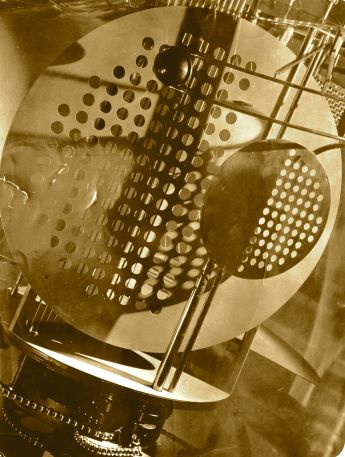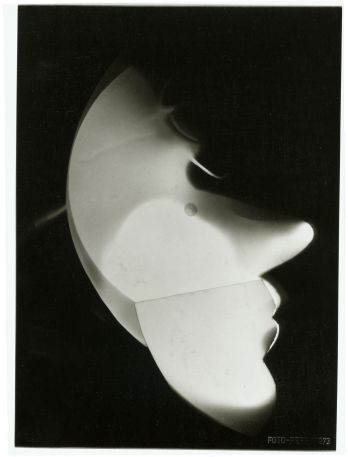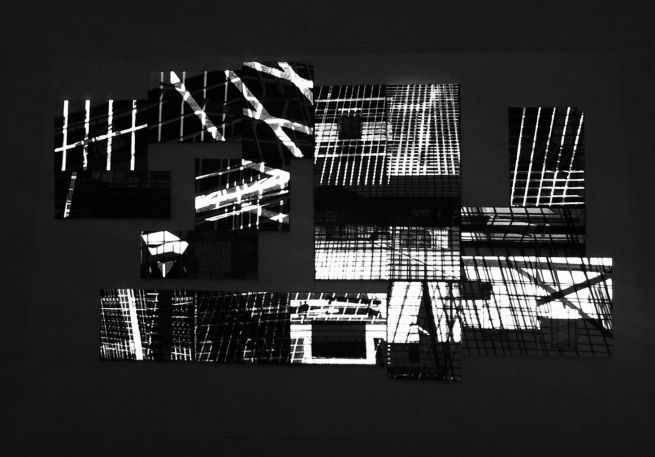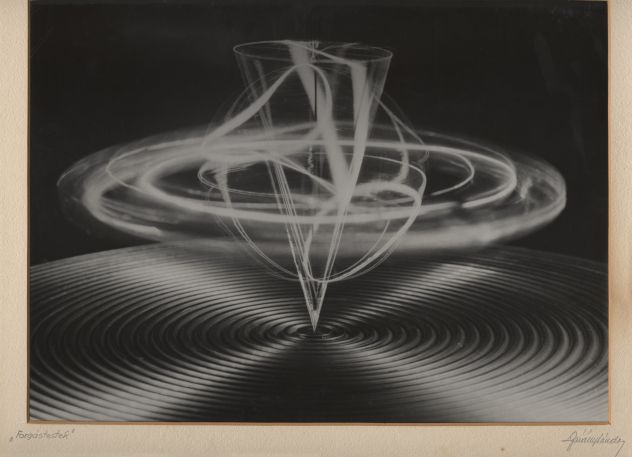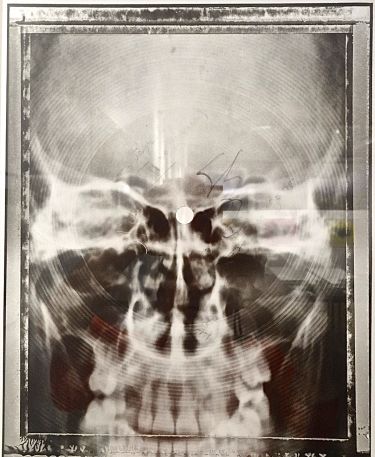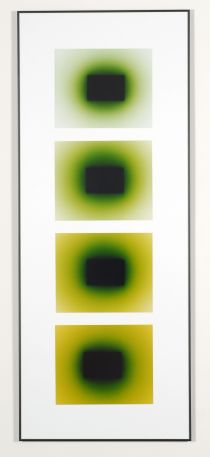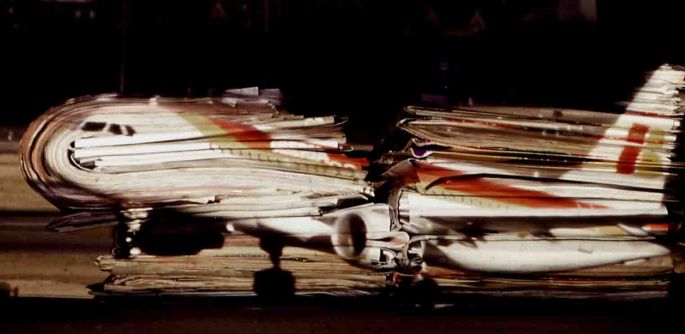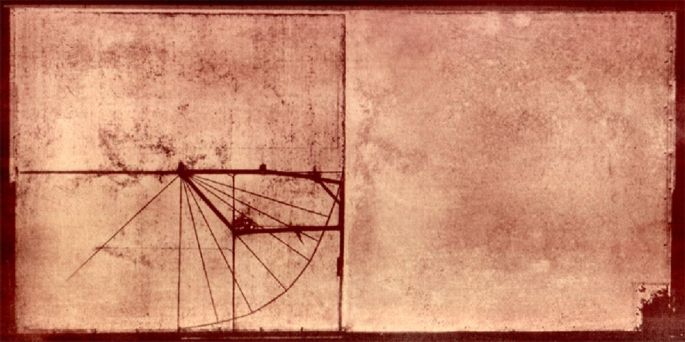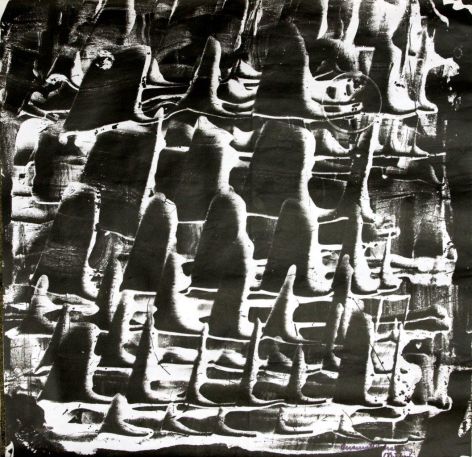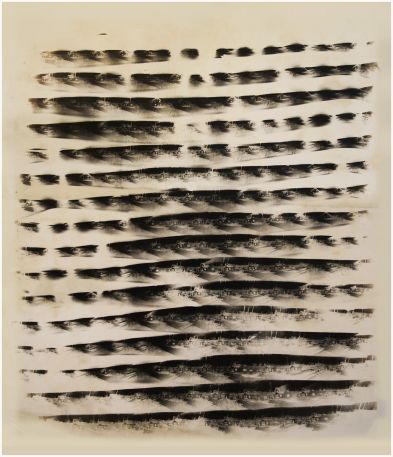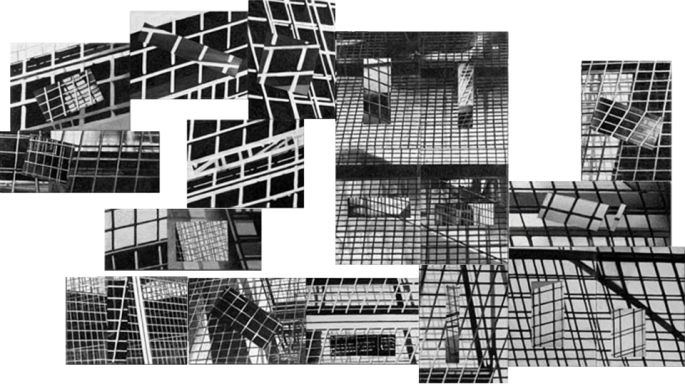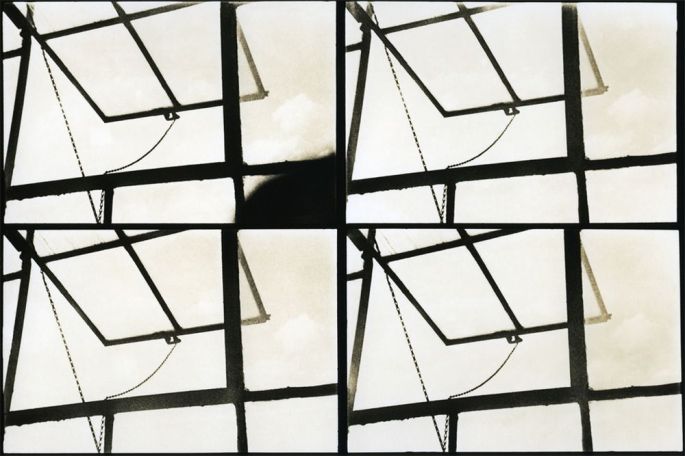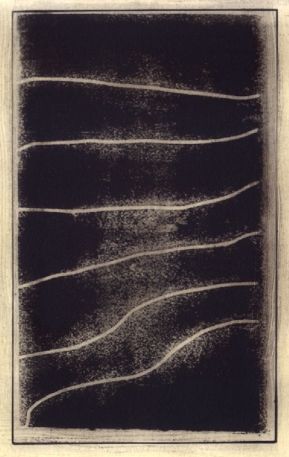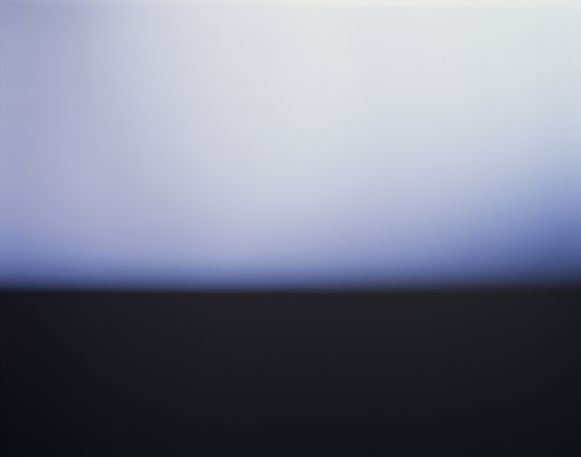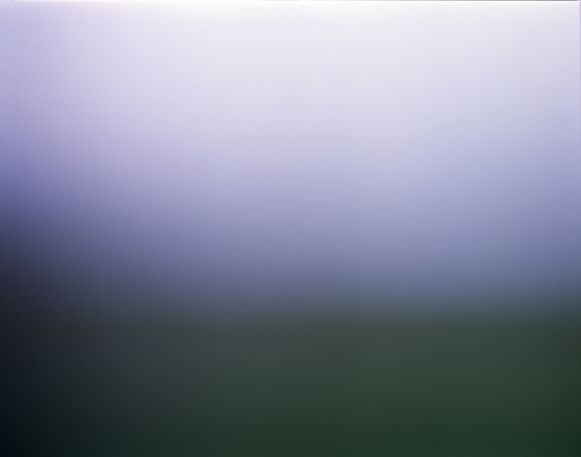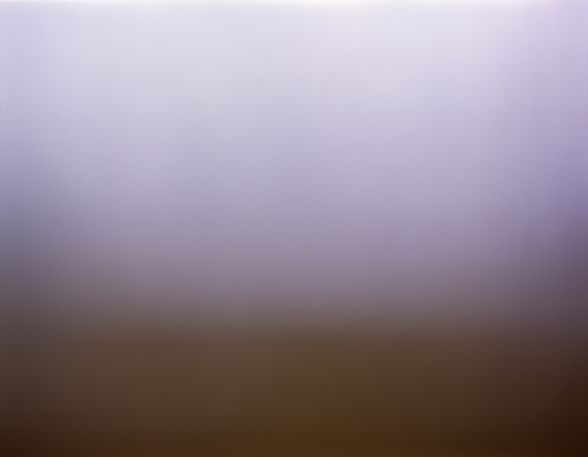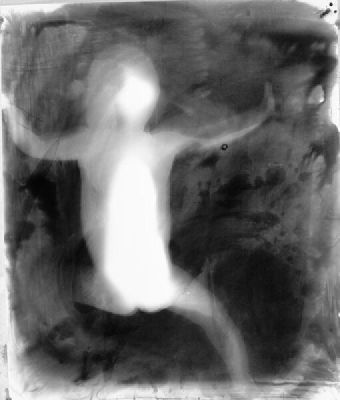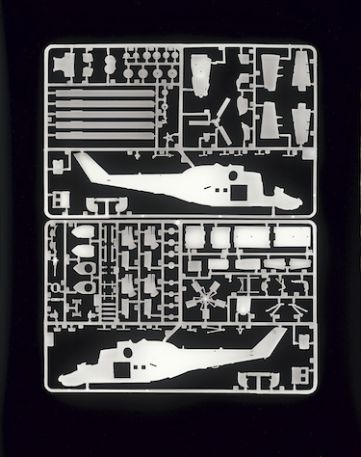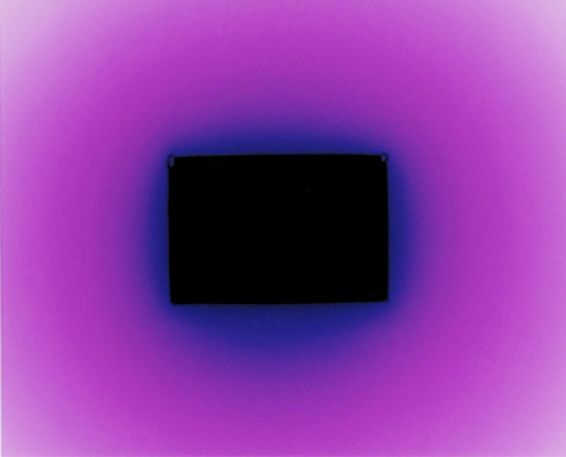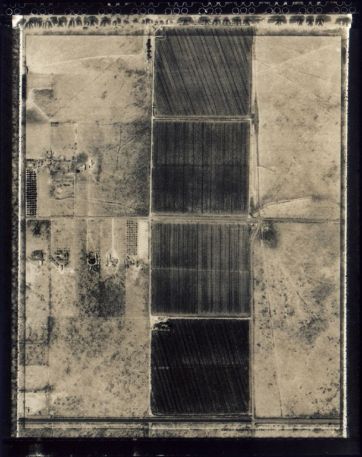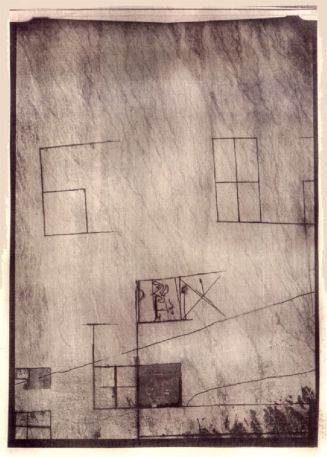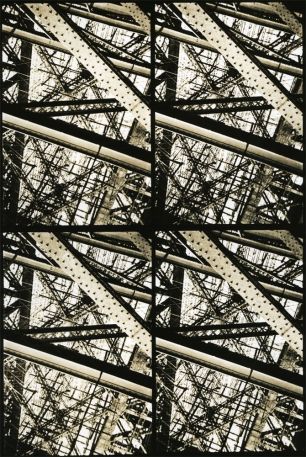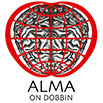
IMPACT: Abstraction & Experiment in Hungarian Photography
Alma Gallery, New York
Various Artists
May 10, 2016 throughJune 18, 2016
IMPACT: Abstraction & Experiment in Hungarian Photography
Nándor Bárány/ Máté Dobokay/ Ágnes Eperjesi/ Enikő Gábor/ Tihamér Gyarmathy/ József Hajdú/ Tibor Hajas/ George Heller/ Antal Jokesz/ György Kepes/ Gábor Kerekes/ Éva Köves/ Ted Kraynik/ György Lõrinczy/ Ádám Magyar/ László Moholy-Nagy/ Szacsva y Pál/ Balázs Sprenc/ Dezső Szabó/ Andrea Sztojánovits/ Balázs Telek/ Magdolna Vékás/ János Vető
The Bauhaus was a hothouse of European modernism between the world wars, where Hungarians helped forge innovative conceptions for the visual and performing arts. László Moholy-Nagy’s radical approach to established mediums and new media was profoundly influential at the Bauhaus in Germany and, later, in America, after Moholy-Nagy settled in Chicago in 1937 and resurrected Bauhaus principles at what became the Institute of Design.
Instead of using a camera, László Moholy-Nagy’s photomontages and photograms rely on scissors and placing bodies or objects directly onto photographic paper. His Photogram self-portrait, evidently made by curving cut photographic papers around his face, upended the notion of photography as a static art. It was also, along with his joint portrait photogram with his wife, Lucia, a radical restatement of portraiture. Moholy’s more abstract photograms of forms and shapes apparently floating in space find echoes in the works of György Kepes and Tihamér Gyarmathy also exhibited here. Moholy-Nagy’s photomontages, which he termed “photoplastics,” are indebted to Dada and filled with surrealist allusion but their blend of art and commercial design techniques is typically Bauhaus.
Moholy-Nagy’s recently discovered film on the functioning of a color “Light Machine” bespeaks his lifelong fascination with light and other fundamentals of art, as well as with pioneering unifications of art and technology, such as those also forged in the exhibits of Ted Kraynik’s “Video Luminar,” newly rediscovered, remastered, and premiered on this exhibition, and George Heller’s experiments in computer graphics. Moholy-Nagy’s color film also presages the contemporary light-painting art and VJ culture that are embraced in the multimedia “Monochrome Clark 1.2,” by the eponymous group comprised of artists Éva Köves & Andrea Sztojánovits, with a music mix by Kinga Kovács a.k.a. DJ Sanyi.
In differing ways, the roughly twenty modern and contemporary artists in this exhibition share or extend Moholy-Nagy’s experimental impulse and his tendency toward stripped-down abstraction.
Dezső Szabó employs a Tesla apparatus to electrify a metal airplane model until it emits St. Elmo’s fire, while Sacsvay y Pál’s image of an airplane is a projection distorted over a pile of files. Máté Dobokay leaves his camera opened wide to capture subtle vibrations of color. Ágnes Eperjesi’s color photograms explore the operation of pure, colored light. Enikő Gabor transforms her living room into a camera obscura, photographing her neighbor’s property through blinds that work as shutters. In “Surface Torture III,” Tibor Hajas and János Vető express their angst in Soviet-era Hungary by burning their negative. The body-connection in Balázs Sprenc’s photogram includes a chemical interaction with his post-operative bandages.
Gábor Kerekes viewed photography itself as an alchemical juncture between art and science. His drone’s-eye-view anthracotypes of the US military area Roswell link surveillance and secrecy, fact and fiction—and recall Kerekes’s own past as a state informer. The tension between current observation and historic techniques occurs also in Magdolna Vékás’s work, represented here through her images of post-9-11 New York printed a decade later onto offset-litho plates. József Hajdú’s haunting “X-Ray Record No.98.02” is a contact print made from a thick, emulsion-coated X-Ray sheet, which sound technicians at Hungarian Radio re-used to cut music records, due to the shortage of material in Hungary during the 1930s.
------------
REVIEWS and more IMAGES:
Please visit AlmaOnDobbin on Facebook.
This exhibition was followed by “ECHOES: City, Society, Conflict & Self in Hungarian Photography” (June 24 through July 30, 2016). Both exhibitions were curated by Gary van Wyk, with consulting curators from the principal lending institutions, Dr. Péter Baki, Director of the Hungarian Museum of Photography; Asst. Prof. Gábor Arion Kudász of Moholy-Nagy University (MOME); Dr. Márton Orosz, consultant to the Kepes Institute in Eger; and Dr. Luca Gõbölyös, Szilvi Mucsy, Carole Naggar, Tomas Opitz, and Dr. Sándor Szilágyi.
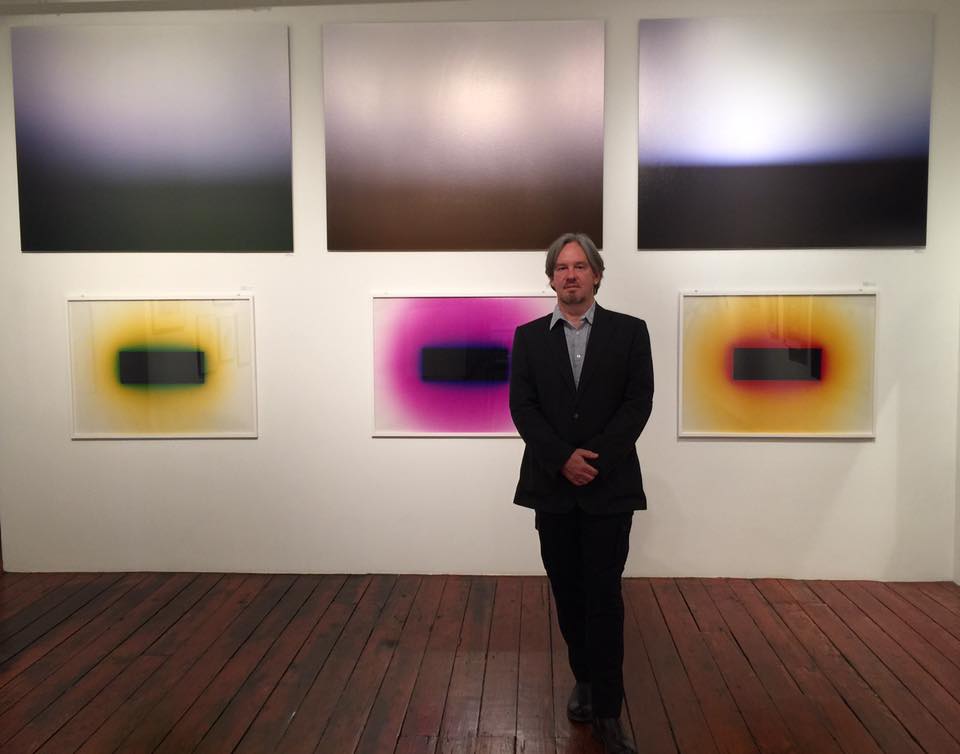
Installation view with curator Gary van Wyk.
The exhibitions were co-presented by AlmaOnDobbin, Consulate General of Hungary, Balassi Institute, and Art Market Budapest as part of Modernity X Hungary—A Festival of Hungarian Modernism in New York, sponsored by the Ministry of Foreign Affairs and Trade, Hungary.
-
Artist biographies
Nándor Bárány (1899-1977) is regarded as one of Hungary’s first exponents of the New Objectivity. His primary aim was to manifest abstract ideas in photographic form, and he was a keen experimenter. His contribution was internationally recognized, and he received American Photography’s Honourable Mention Award. A leading optician, he was involved in the creation of a soft-lens system in 1932, which was sold under the name Hafár by the company HAFA, and was the first person in Hungary to produce the “T” coating reducing reflections. He was the author of many specialist works, including the six-volume Optikai műszerek elmélete és gyakorlata [Theory and Practice of Optical Instruments] (1947–1956), which is a standard work in the fields of optics and photography. Qualified as a mechanical engineer, he was a university lecturer and an associate member of the Hungarian Academy of Sciences. Between 1931 and 1939, he received eighteen awards at foreign exhibitions. In 1951, he was awarded the Kossuth Prize in recognition of his work.
Máté Dobokay (b. 1988) is interested in conceptual art and experimental photography, particularly though manipulating the medium and neglecting the apparatus. He is a board member of the Studio of Young Photographers Hungary (FFS) and a member of Studio of Young Artists’ Association (SYAA/FKSE). He received a Republican Scholarship for 2015‐2016, was shortlisted for the Leopold Bloom Award in 2105. During 2014, he was a member of the winning team at OFF_Festival, Bratislava, and was nominated for the Lucien et Rodolf Hervé Prix. He has had five solo exhibitions and featured in several group shows.
Ágnes Eperjesi (1964-) studied photography and typography at the Hungarian Academy of Arts and Crafts and at the Minerva Academy of Groningen (NL). She received her Master's degree in visual communication in 1991, and her DLA in 2010 at the Hungarian Academy of Fine Arts. She is a senior lecturer in the Intermedia Department at the Hungarian University of Fine Arts, Budapest. In her work, she attempts to expand the scope of photography without a camera, either to create a conceptual visual world, or to provide a personal reinterpretation and visual enhancement of everyday, ready-made clichés. Outside of Hungary, she has had solo exhibitions in New York (2006,1999), Philadelphia (2006), Houston (2002), Amsterdam (2004), and Frankfurt (1999), and has taken part in group exhibitions in China, Japan, South America, and many venues in Europe. Her works are featured in several public and private collections in Hungary and internationally.
Enikő Gábor (1972- ). Having won the Domanovszky award, Enikő Gábor completed her schooling at the High School for Fine and Applied Arts, Budapest. She followed a painting degree (1996) with graduate qualifications to teach art and art history at the Hungarian University of Fine Arts. Her innovative approaches to photography, including series of photograms and camera obscura works, have garnered several awards. She received the Pécsi József Photography Scholarship (1996-99), the National Association of Hungarian Creative Artists award (1998), the Divald Károly Prize, and the Grand Prize at the 12th Esztergom Photography Biennial (2000). Gábor’s photography has often featured in solo and group exhibitions, photography festivals, biennials, and group exhibitions in Hungary, France, Italy, Slovakia, and India.
Tihamér Gyarmathy (1915-2005). After graduation from the Hungarian Academy of Fine Arts, Gyarmathy traveled to Italy, France, and Germany (1937-39), meeting Piet Mondrian, István Beöthy, Jean Arp, André Breton, and Max Bill, and staging his first solo exhibitions in Paris and Zurich in 1938. In 1945 he joined the Hungarian artist group known as the European School, and helped found the Hungarian Group of Abstract Artists and the Gallery for the Four Cardinal Points in 1946. In 1947, he exhibited in the Salon des Réalites Nouvelles in Paris, and had a solo exhibition in Budapest in 1948. Shortly thereafter, the European School and abstract art were suppressed by the State until the 1960s, when Gyarmathy could exhibit again in Hungary and abroad. From 1971 onward he was able to visit Western Europe, and in 1973 he went on an African tour. He received numerous foreign awards, and was inducted into the Hungarian Art Academy in 1991 and into the Széchenyi Art Academy in 1993.
Tibor Hajas (1946–1980), poet, writer, self-taught conceptual artist, introduced performances, actions, and body art in Hungary. His early actions (1969-1975) were documented by several photographers, including Júlia Veres, János Szerencsés, Tibor Zátonyi, and particularly János Vető, with whom he partnered after 1975 to form a collaborative pair, as did several other neo-avant-garde Hungarian artists. Their joint works consisted of Hajas’s one-man performances witnessed only by Vető, who distilled them through his creative camerawork and printing. Hajas’s works, writings and principles inspired many artists, including Vető, Lenke Szilágyi, and Zsuzsi Ujj. Hajas was tragically killed in a car crash.
József Hajdú (b.1961) trained in chemical engineering and photography. After his work was shown in 1992 at an exhibition on Hungarian “Postal Architecture” at the Postal Museum, he was employed there as a photographer and photo archivist. He joined the Studio of Young Photographers (FFS) in 1987, and the Association of Hungarian Photographers in 1994. Receipt of the Pécsi József Photographic Art Scholarship (1993-1996) enabled him to publish his first book, Ipari táj [Industrial Landscape] (1998). He received a Polaroid Final Art Award In 1998, and in 2007 the Balogh Rudolf Award. He has had six solo shows and featured in numerous group exhibitions. His architectural albums are among the masterpieces of Hungarian book publishing.
George C. Heller (1924-2013) learned design in his family’s printing business. Arriving in the US as a Holocaust survivor, he graduated from MIT electrical engineering in 1959, and joined IBM as a computer programmer, where his long and successful career included publishing many technical books. An enthusiastic educator, he taught high school students about computers in the late 1950s, and pioneered Computer Science degree programs. In the mid 1960s, George invited children, adults, and the elderly to draw pictures on computers, and the results were exhibited internationally—a precursor of today’s ubiquitous computer images. Then, George posed the prescient question, “Would anyone want access to a computer in their home?” To explore that question, IBM installed a computer terminal in George’s home in the early 1970s, and he became a pioneer of home computing.
Antal Jokesz (1952–) was one of the most prominent figures in Hungarian neo-avant-garde photo art, exhibiting in several solo exhibitions as well as the key group shows between 1976 and 1983. Between 1979 and 1982, he organized and co-curated (with János Szerencsés) the annual Dokument exhibitions, which presented the period’s most engaging work. Jokesz’s photographic artworks interrogate such fundaments of photography as the medium, time, space, and documentarism. In 1999 he published In Search of Prepared Time, a volume of his texts on photography.
György Kepes (1906-2001) was a member of Lajos Kassák’s Work Circle and assistant at the Bauhaus to László Moholy-Nagy, who later put him in charge of the Light Workshop at the New Bauhaus, Chicago, where Kepes had his first solo show in 1939 at Katharine Kuh’s gallery. His Language of Vision (1944) summarized his pedagogy. From 1946 to 1974, Kepes taught visual design in MIT’s School of Architecture and Planning. His 1954 Rockefeller Foundation grant supported his book The Perceptual Form of the City (1959). A Guggenheim Foundation grant underwrote his book Light as Creative Medium, ideas Kepes also translated into an exhibition at Harvard’s Carpenter Center, and into a programmed light mural for the New York headquarters of KLM. Kepes edited the six-volume Vision and Value series (1965). He established and led MIT’s Center for Advanced Visual Studies (CAVS), where artists, scientists, and engineers collaborated on environmental and social solutions. His major retrospective exhibition opened in Budapest at the Műcsarnok/Kunsthalle in 1976, and toured to Vienna’s Künstlerhaus, and the Bauhaus Archives, Berlin. In 1984 the Polaroid Corporation commissioned a series of large Polaroids.
Gábor Kerekes (1945-2014) was a central figure in Hungarian neo-avant-garde photography until the early 1980s. His Alchemy series, which he worked on for seventeen years from the late 1980s onward, positions the human in the frame of the universe. His Over Roswell series (2002-2005), in part, imagines what signs of our civilization an approaching alien would read from the surface of Earth. Kerekes continually probed the limits of the photographic medium, exploring dozens of techniques, from the most archaic to the most cutting-edge. He held more than thirty solo exhibitions and is represented in collections worldwide.
Kinga Kovács (1973-). A DJ broadcaster at the legendary Central-Eastern European community radio Tilos in Budapest by night and weekends, a copywriter, writer, and translator by day, Kinga Kovacs, a.k.a. DJ Sanyi, is a producer of collages that combine the spoken word and music to provide inspiring backgrounds to visual installations. She studied at the English Department of a prestigious Budapest university (ELTE), where several professors encouraged her experiments with recorded literary texts and music. These word-plays resulted in her regular Sunday afternoon radio shows, which have been running for more than a decade now. She has organized several multimedia literary performances featuring Hungarian and English-language writers with musical and visual accompaniment.
Éva Köves’ (1965-) installations are inspired by the geometric, Constructivist, and anti-mainstream tendencies of the 1920’s, especially by László Moholy-Nagy and Lajos Kassák. In 1997, she was selected for the Hungarian Pavilion at the Venice Biennale. She has had more than 30 solo exhibitions in Europe, notably at the Ludwig Museum Budapest (2001), and a similar number of international group shows, including showcases of Central European art, such as “The View from Here: Recent Pictures from Central Europe and the American Midwest.” Though a collaborative project called “Common Things” planned for the Venice Biennale in 2011 failed to materialize, the kernel behind it—sharing, cooperation, interdependence—has become her current focus, symbolized by the beehive.
Ted Kraynik (1917-). Known mainly as a sculptor, Kraynik was a professor of art at the University of Milwaukee. In 1965 he exhibited at the Art Institute of Chicago. In 1968 he produced the television piece “Video Luminar,” which he first showed at Howard Wise Gallery, New York, and later in the pioneering "Vision & Television" exhibition at the Rose Art Museum, Brandeis University. The New York Times reviewed his work just before the latter show, at the end of 1969. In 1969 he was awarded a fellowship at MIT to study art and technology at György Kepes' Center for Advanced Visual Studies. In 1973 he exhibited at Contemporary Art Center in Cincinnati, Ohio in a group exhibition. Today, the early inroads made by such pioneers as Kraynik are taken for granted.
György Lőrinczy (1935-1981) broke with conventional Hungarian photography during the mid 1960s, instead employing his camera and enlarger as tools for art photography, producing non-figurative images, such as close-ups of stones, driftwood, oil, or globs of glue in microscope slides. After organizing the influential Workshop exhibition in 1967, he spent two months in New York during Fall 1968, and published New York, New York in 1972, which has become a collector's classic, reflecting New York is a black-and-white Pop aesthetic. He settled in New York in 1972, and served as photo editor of Art Rite for two years, under the pseudonym Yuri. During the last decade of his life he worked in a postmodern style.
Ádám Magyar (1972-), studied music and technology before turning to art. He bends conventional representations of time and space, stretching seconds into minutes and freezing moments impossible to see with the naked eye. For his Stainless series he adapted an industrial production-line scanner, designed for quality control, and customized its software to photograph subway cars pulling up to platforms. Each photograph presents an impossibly detailed view inside the subway cars. The scanner removes perspective and illuminates the passengers to form studio-like portraits. Magyar has been exhibiting for ten years internationally, and has had several US solo shows. He has been extensively interviewed and written about, and invited to speak about his work.
László Moholy-Nagy (1895-1946). Moholy-Nagy turned to art while recuperating from war wounds sustained in 1915. In 1919, politics caused his flight to Vienna, where he became acquainted with Lájos Kassák, who urged him to join the Bauhaus. In Berlin, he met his first wife, Lucia Schultz, who taught him photography. He remained obsessed with light for the rest of his life. He named the photogram, of which he was the most influential practitioner, a “drawing with light.” His photomontages, influenced both by Dada and Surrealism, forged new associations from fragmented realities. His dramatic photographic perspectives, influenced by Constructivism, expressed a “new vision” of modernity that harnessed technology and the machine to serve human progress. Walter Gropius invited Moholy, aged twenty-six, to teach at the Bauhaus, where Moholy took charge of the foundational course. He experimented with the fundamentals of various media, becoming one the world’s first multimedia artists—before the term was invented. With the rise of fascism, Moholy, who was Jewish, moved to the Netherlands, then to England and, finally, to the US, where Gropius invited him to establish the New Bauhaus in Chicago. When the New Bauhaus failed, Moholy established his own School of Design, which became the College of Design in 1944 and was later integrated into the Illinois Institute of Technology. He died of leukaemia.
Monochrome Clack is a trans-generational, multimedia collaborative group formed by Éva Köves and Andrea Sztojánovits (see separate bios) in 2009. Andrea Sztojánovits projects her computer animation (movement, light, sound) onto Éva Köves’ two-dimensional works, typically paintings on photographs mounted on canvas, creating a new medium that is closely linked to Moholy-Nagy’s theories and his experiments of mixing media and manipulating light. The effect is enhanced by a musical component, in the case of the work on exhibition, "Monochrome Clack 1.2", a music mix by Kinga Kovács, a.k.a. DJ Sanyi.
Balázs Sprenc (b.1978) is a member of the Association of Hungarian Photographers, as well as the Random, Errorism, and InstArt groups. He is particularly interested in analog photography, old film cameras, and historical and alternative photographic processes. His recent focus is chemigrams and the wet plate collodion process. He has been included in group shows in Hungary, Slovakia, Czech Republic, Italy, Romania, Germany, and the UK.
Dezső Szabó (b.1967) studied painting at the Hungarian Academy of Fine Arts before turning to photography. He stages recreations of events and natural phenomena; using smoke machines, water circulators, pyrotechnics, and high-voltage fields, he creates images that appear to document natural events and disasters, but that point instead to the process of photography. He uses a Tesla apparatus to create the static-electricity charge that produces the effect known as St. Elmo’s fire, blending the aesthetic and scientific features of fine art and scientific photography. His photogram of a helicopter model offers an exploded and flattened view of a complex machine.
Andrea Sztojánovits (b.1979) graduated from the Intermedia and Pedagogy Departments of the Hungarian Academy of Fine Arts in Budapest in 2009, where she is currently a doctoral student. For about ten years, she has been a video performer or VJ, creating improvised audiovisual performances, and the focus of her work is connecting this practice to the fine arts through installation and performance.
Balázs Telek (1974-2015) studied graphics and visual communications. His interests in experimental photography included the camera obscura, anamorphic photography, and 3D video installations. He was a member of many groups and associations and a founding fellow of the International Kepes Association. In 2005 he received a Rudolf Balogh prize, Hungary’s top photography prize. He founded Art Bázis, a center for young photographers, and FotóFalu/PhotoVillage, which works as a summer university for photographers. He taught at various colleges and gave several courses about alternative photographic processes at the House of Hungarian Photography.
Magdolna Vékás (b.1956). Professionally trained as a photographer, Vékás was staff photographer at Semmelweis Medical History Museum for ten years. A member of several photographers’ and artists’ associations, she was a founder of the Első Alkotócsoport (First Creative Group). She currently teaches photography and historical photographic processes, her special interest. Her volume of cyanotypes was published by Nádai Studio in 1997, followed by Fragments of the City. In 2000, she received the Balogh Rudolf Award, Hungary’s top photo award. Her retrospective at Mai Manó House was entitled “Thirty Years.” (2007). In 2002, she came to New York on a tour for professional photographers, and this body of work finally took form as a 2012 series of enlargements on aluminum offset plates.
János Vetõ (1953–), photographer, self-taught painter, and musician, was a leading figure of non-conformist photo art in Hungary’s neo-avant-garde period (up to 1980) and the New Wave period that followed, and continues his approach today. During the second half of the 1970s he collaborated with the body artist Tibor Hajas, assisting and photographing Hajas’s actions. They also jointly created photographic art works in which Hajas performed solely for Vetõ, who was already independently renowned for his photographic work that radically challenged the conventions of portraits, selfportraits, and nudes. After Hajas’s accidential death, Vetõ collaborated with the painter Lóránt Méhes (Zuzu), and began applying paint onto his photographs. In 1991, Vetõ moved to Copenhagen.
Szacsva y Pál (b.1967) undertook graduate studies at the Hungarian University of Fine Arts (1993-1995), the École Supérieure des Beaux-Arts, Marseille (1996), the Kunsthochschule, Berlin (1999-2000), the Higher Institute for Fine Arts (HISK), Antwerp (2001-2003), and completed his doctorate in media art at the Hungarian University of Fine Arts, Budapest in 2009. He was a DAAD scholarship holder in Berlin in1999/2000, and the winner of the Projections on Lake Competition, Pasadena, CA, in 2008. He has had several solo exhibitions in France, Berlin, and Budapest, including at Musée d’art Contemporain, Bordeaux (2001) and Ludwig Museum, Budapest (2004). He also works in video, and has authored several theoretical texts.
-
PRESS RELEASE
EXHBITION TITLE: “Impact: Abstraction & Experiment in Hungarian Photography”
EXHIBITION DATES: May 10, 2016 through June 18, 2016
OPENING RECEPTION: May 7, 2016, 6PM-9PM
“Impact: Abstraction & Experiment in Hungarian Photography” includes 21 modern and contemporary artists. It juxtaposes László Moholy-Nagy’s photograms and photo-collages with early examples by György Kepes and Tihamér Gyarmathy (1915-2005), pioneering experimentations with video and computer graphics by Ted Kraynik and George Heller, and novel photographic approaches by several contemporary artists.
Moholy-Nagy’s fascination with new media is evident is his remarkable color film, “Light Machine” (1941), and it is echoed in Theodor Kraynik’s “Video Luminar” (1967), a pioneering video that will premier at Alma following its recent restoration. Equally inventive is Monochrome Clack’s eponymous installation, which features projection over a mosaic of modified black-and-white photographs, with a music mix by by Kinga Kovács a.k.a. DJ Sanyi.
Szacsva y Pál blurs the real and the represented by photographing projections onto objects. József Hajdú made contact prints from thick, plastic, emulsion-coated X-Ray sheets, which sound technicians at Hungarian Radio re-used to cut records, due to the shortage of material in Hungary during the 1930s. Gábor Kerekes’s view of photography, as an alchemical juncture between art and science, led him to explore a wide variety of techniques and subjects, including his drone’s-eye-view anthracotypes of Roswell and Secret Area 51, places where fact and fiction, present and future, seem to meld. The collaborative works of neo-avant-garde and new wave artists Tibor Hajas and János Vető include “Surface Torture III” (1978), in which the artists’ angst is expressed by burning the negative.
This exhibition is immediately followed by “Echoes: City, Society, Conflict & Self in Hungarian Photography” (June 23 through July 30, 2016). Both exhibitions, curated by Gary van Wyk, are presented by AlmaOnDobbin, the Consulate General of Hungary, and Balassi Insitute / Hungarian Cultural Center, and form part of Modernity X Hungary—A Festival of Hungarian Modernism in New York. Lenders include the Hungarian Museum of Photography, Moholy-Nagy University (MOME), the Kepes Institute in Eger, leading Hungarian galleries, collectors in Hungary and the United States, and Hungarian artists in several countries. Alma’s coordinating partner in Hungary is Art Photo Budapest, Eastern Europe’s leading contemporary art event that hosts Art Photo Budapest, one of Europe’s major international photo fairs.
ADDRESS: Alma Gallery: 625 W. 27th Street, New York, NY 10001 (bet. 11th & 12th Aves)
HOURS: Tuesday through Saturday, noon – 7PM
ADMISSION: Free
CONTACT: AlmaOnDobbin@gmail.com
© ALMA 2014
